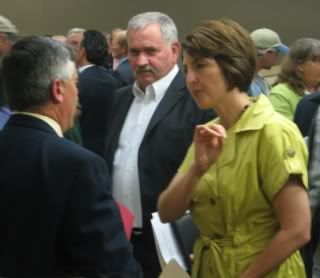Balance in the forest
Last Friday, DTE had the pleasure of covering a listening session on different interests finding common ground in the Colville National Forest, hosted by Sen. Maria Cantwell and U.S. Rep Cathy McMorris-Rodgers. Much credit to keeping a sustainable forest management system is due to the collaborative efforts of the Northeast Washington Forestry Coalition, made up of Conservation Northwest, The Lands Council, timber industry, business leaders and more. Cantwell described them as "breaking the mold."
(U.S. rep Cathy McMorris-Rodgers takes questions after the conclusion of the listening session.)
The funny thing about a blog is you get a second chance to enhance the story. We’re not taking the Andrew Sullivan approach and dissecting which is like taking the dust of the butterfly’s wings, rather giving readers further background on the 1.1 million acres of forest in question. Watch a video on the coalition HERE; take a beautiful photo tour of the Colville Roadless Areas HERE; check out SCAT, Conservation Northwest’s well-written blog on the listening session HERE.
But after the jump, you’ll find a feature that found its way to the DTE news section regarding this critical issue.
Timber and conservation are two entities not always known for collaboration.
Yet since 2003, members of the Northeast Washington Forest Coalition have worked together to develop a common sense of interest between all forest users.
Last Friday at the Washington State University Riverpoint campus, coalition members participated in a listening session on forest management and roadless access, hosted by U.S. Sen. Maria Cantwell and U.S Rep. Cathy McMorris-Rodgers.
At the session titled “Communities, Collaboration, and the Colville National Forest,” panelists representing a broad spectrum of interests– conservation, tourism, lumber, cattle and government–urged Congress to support a balanced management of the Colville National Forest.
No easy task, as Cantwell said, when “everybody in the room sees potential.”
Mike Petersen, executive director of The Lands Council, praised the success of the coalition–there has been no appeals for litigation since forming– but expressed concern that the Colville National Forest planning staff only recognized four roadless areas as suitable for wilderness designation.
The Coalition wants consideration for all but one of the 19 eligible areas.
“Once most people see how wilderness provides a balance to the more managed lands on the forest where multi-use activities occur, they get it,” Peterson said. “Once they learn that wilderness preserves rights to ride horses, hunt, fish, and experience a bit of our fading frontier heritage, they say, OK, I can support that. These are the last few places remaining in our region that are relatively ecologically intact landscapes without human interference.”
Cantwell agreed, recommending to Colville Nation Forest Supervisor Rick Brazell that only four of 19 roadless areas for wilderness use was not exactly balanced.
On the tourism side, panelist John McGee, owner of 49 degrees North Ski Area, urged Congress to consider wilderness legislation to safeguard the Colville National Forest’s special roadless lands.
Empathy for each point of view, McGee said, included recognizing the “three pillars of good stewardship: social, environmental, and economic.”
For tourism, Ken Barker, president of Tri-County Motorized Recreation Association, said with mines closing due to mineral depletion that motorized tourism usage like ATVs can take place where industry failed.
Spokane Mountaineers president Jeff Lambert said the coalition “has changed the way we look for disqualifying factors on wilderness area.”
What’s at stake: Old-growth forests and endangered wildlife like the Salmo-Priest Additions which are home to mountain caribou.
“Everybody is giving up something here,” he said. “But the roadless areas need designation to pass on to future generations.”
Founded in 1915, the Mountaineers are a 900-member club that provides education andevents on like climbing, hiking, and paddling. Members have engaged in conservation issues and habit restoration.
The economic side was also discussed, since northeastern Washington depends on timber.
While the Coalition has helped the Forest Service increase its timber harvest three-fold to 61 million board feet in 2008, part of supporting a balanced package includes security for northeastern Washington’s timber mills and forest workers.
This includes the privately owned Vaagen mill in Colville, which is struggling to keep people employed. In Pend Oreille County, where the county is 65 percent forest land, a new wildernesdesignation could further redefine an economy that is grasping at straws. Pend Oreille County Commissioner Diane Wear noted unemployment in the northern parts is 19.6 percent.
Colville-area mills aren’t the only businesses affected by possible changes in forest management. Ponderay Newsprint has suspended its operations for two weeks due to less demand from newspapers for paper.
Still, the session seemed like a win for wildlife.
“The challenge is to bring along skeptics of wilderness, which is more permanent than timber plans,” said McMorris-Rodgers. She touted the collaborative effort as “the Washington Way, a model on moving forward with forest management.”
What will come from the forum remains to be seen but Congress is definitely listening, especially with regards to further wildlife protection, Cantwell said.
“Cathy and I will go to work for you on putting this at the forefront for a legislative opportunity,” she said.
